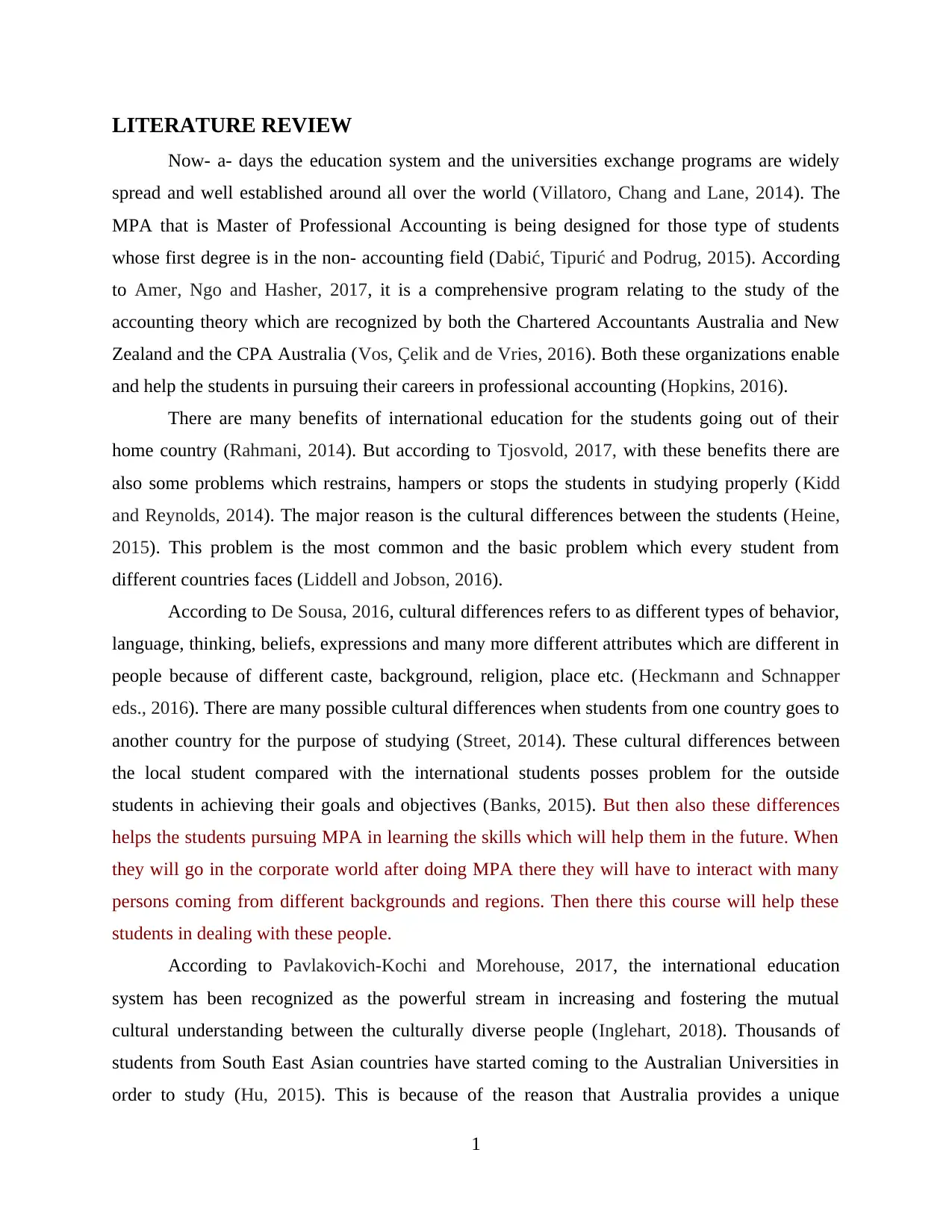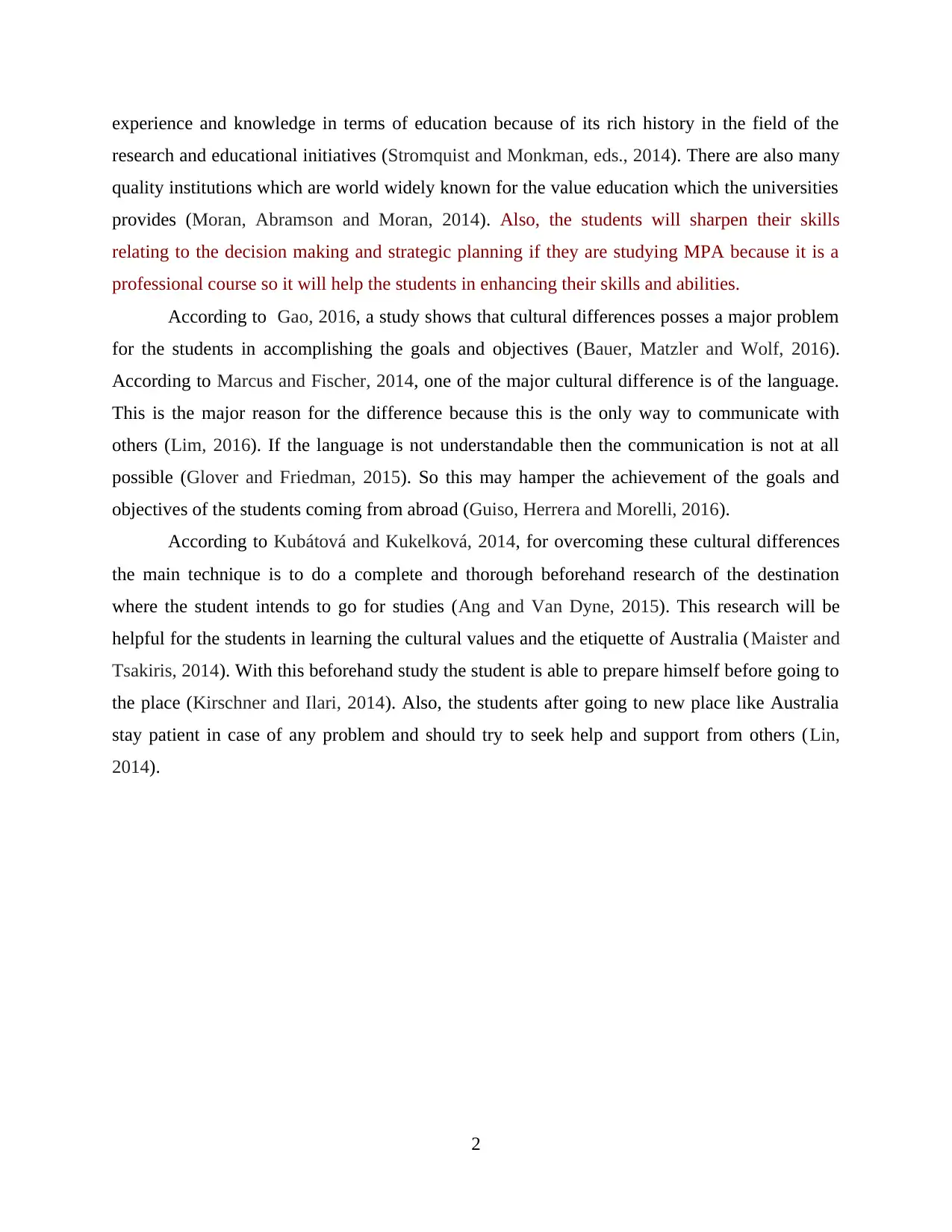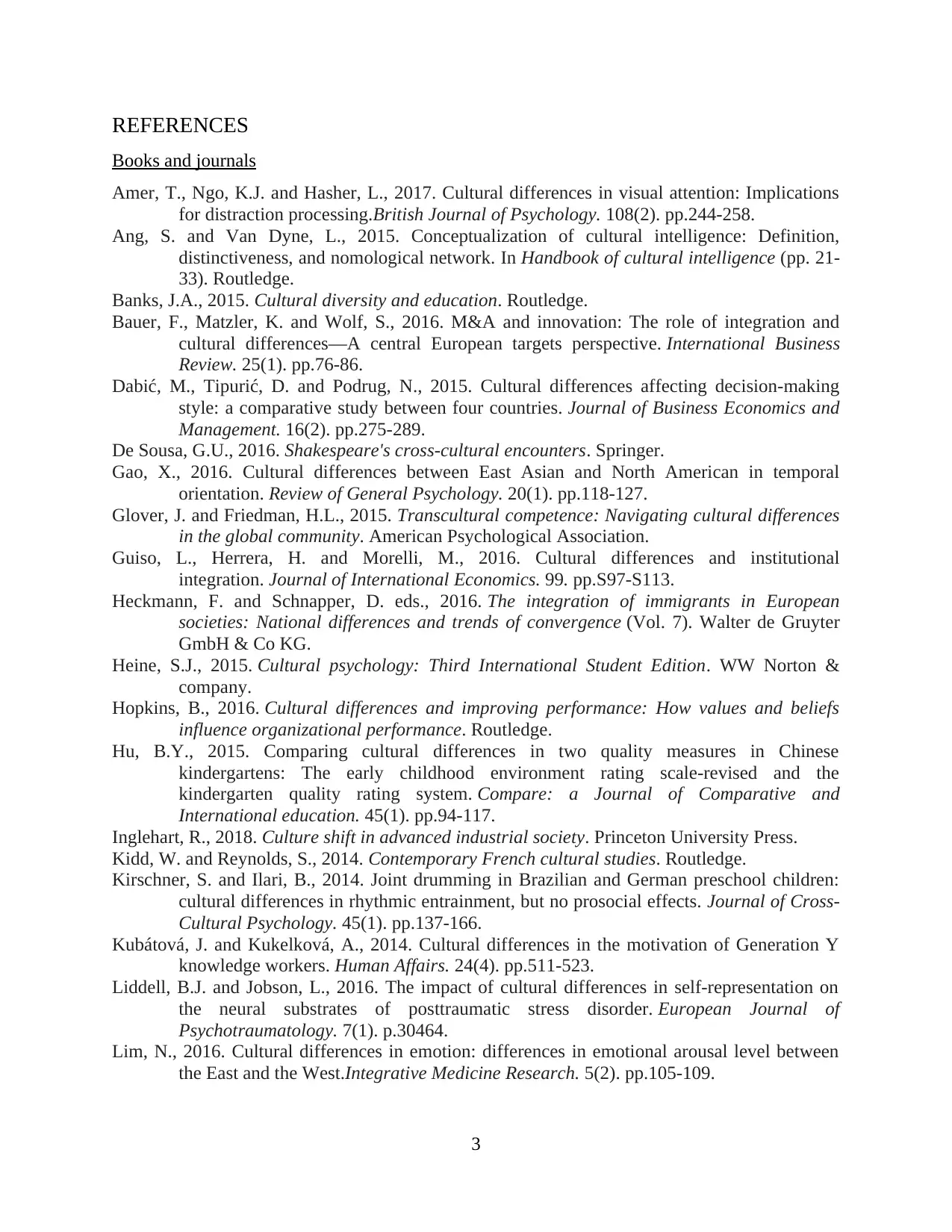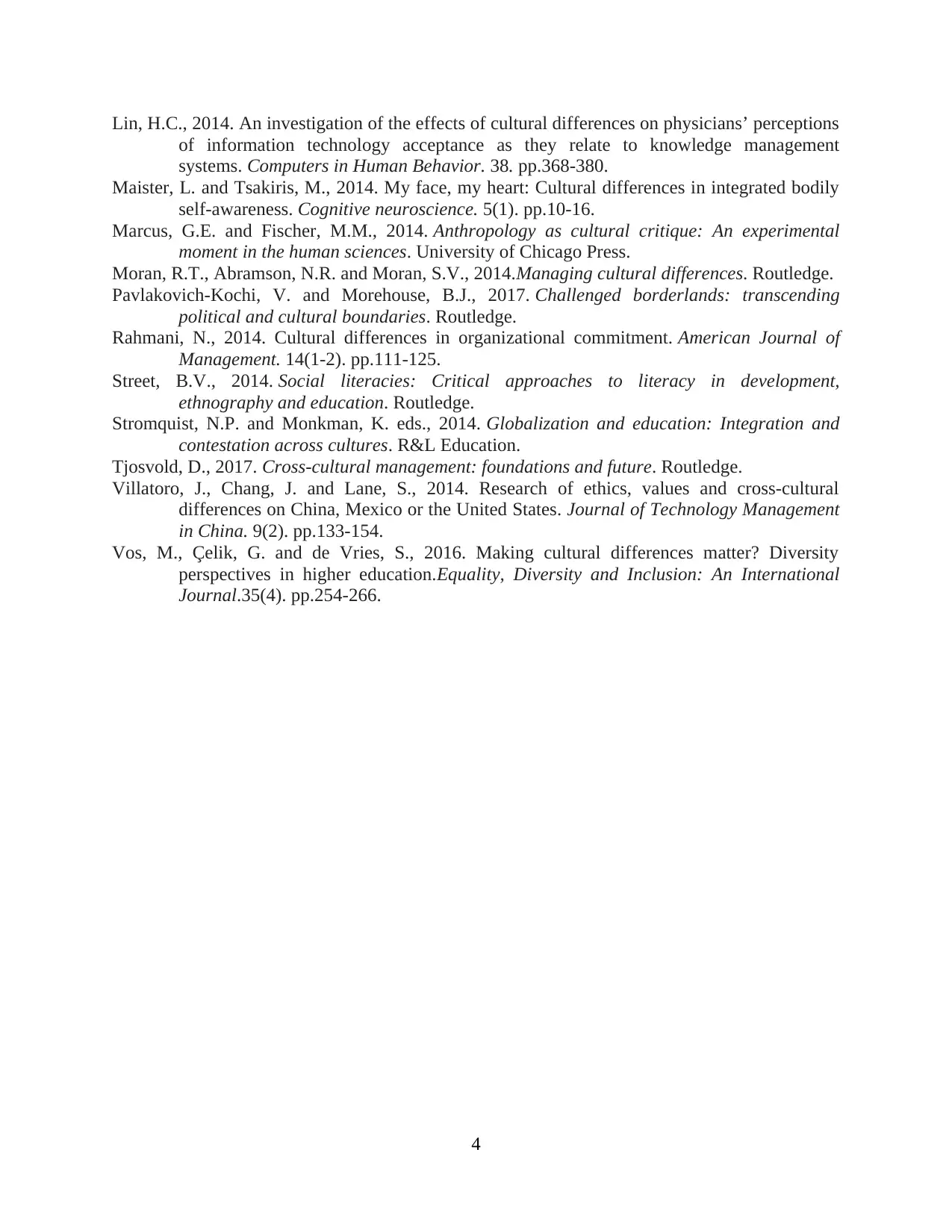International Students and Cultural Differences in MPA Programs
VerifiedAdded on 2020/11/23
|6
|1745
|147
Report
AI Summary
This report presents a literature review on the impact of cultural differences on international students enrolled in Master of Professional Accounting (MPA) programs. It examines the challenges faced by students due to differences in language, behavior, thinking, and beliefs, and how these differences can affect their academic performance and overall experience. The review synthesizes research from various sources, including books and journals, to highlight the significance of cultural understanding in the context of international education. It discusses the benefits of international education while acknowledging the problems that cultural differences can pose. The report further explores how universities, particularly in countries like Australia, can help students navigate these challenges and develop skills for future professional interactions in a diverse global environment. The review also emphasizes the importance of pre-study research and seeking support to overcome cultural barriers. The report is available on Desklib, a platform providing AI-based study tools, past papers, and solved assignments for students.

Research project
Paraphrase This Document
Need a fresh take? Get an instant paraphrase of this document with our AI Paraphraser

Table of Contents
LITERATURE REVIEW................................................................................................................1
REFERENCES................................................................................................................................3
LITERATURE REVIEW................................................................................................................1
REFERENCES................................................................................................................................3

LITERATURE REVIEW
Now- a- days the education system and the universities exchange programs are widely
spread and well established around all over the world (Villatoro, Chang and Lane, 2014). The
MPA that is Master of Professional Accounting is being designed for those type of students
whose first degree is in the non- accounting field (Dabić, Tipurić and Podrug, 2015). According
to Amer, Ngo and Hasher, 2017, it is a comprehensive program relating to the study of the
accounting theory which are recognized by both the Chartered Accountants Australia and New
Zealand and the CPA Australia (Vos, Çelik and de Vries, 2016). Both these organizations enable
and help the students in pursuing their careers in professional accounting (Hopkins, 2016).
There are many benefits of international education for the students going out of their
home country (Rahmani, 2014). But according to Tjosvold, 2017, with these benefits there are
also some problems which restrains, hampers or stops the students in studying properly (Kidd
and Reynolds, 2014). The major reason is the cultural differences between the students (Heine,
2015). This problem is the most common and the basic problem which every student from
different countries faces (Liddell and Jobson, 2016).
According to De Sousa, 2016, cultural differences refers to as different types of behavior,
language, thinking, beliefs, expressions and many more different attributes which are different in
people because of different caste, background, religion, place etc. (Heckmann and Schnapper
eds., 2016). There are many possible cultural differences when students from one country goes to
another country for the purpose of studying (Street, 2014). These cultural differences between
the local student compared with the international students posses problem for the outside
students in achieving their goals and objectives (Banks, 2015). But then also these differences
helps the students pursuing MPA in learning the skills which will help them in the future. When
they will go in the corporate world after doing MPA there they will have to interact with many
persons coming from different backgrounds and regions. Then there this course will help these
students in dealing with these people.
According to Pavlakovich-Kochi and Morehouse, 2017, the international education
system has been recognized as the powerful stream in increasing and fostering the mutual
cultural understanding between the culturally diverse people (Inglehart, 2018). Thousands of
students from South East Asian countries have started coming to the Australian Universities in
order to study (Hu, 2015). This is because of the reason that Australia provides a unique
1
Now- a- days the education system and the universities exchange programs are widely
spread and well established around all over the world (Villatoro, Chang and Lane, 2014). The
MPA that is Master of Professional Accounting is being designed for those type of students
whose first degree is in the non- accounting field (Dabić, Tipurić and Podrug, 2015). According
to Amer, Ngo and Hasher, 2017, it is a comprehensive program relating to the study of the
accounting theory which are recognized by both the Chartered Accountants Australia and New
Zealand and the CPA Australia (Vos, Çelik and de Vries, 2016). Both these organizations enable
and help the students in pursuing their careers in professional accounting (Hopkins, 2016).
There are many benefits of international education for the students going out of their
home country (Rahmani, 2014). But according to Tjosvold, 2017, with these benefits there are
also some problems which restrains, hampers or stops the students in studying properly (Kidd
and Reynolds, 2014). The major reason is the cultural differences between the students (Heine,
2015). This problem is the most common and the basic problem which every student from
different countries faces (Liddell and Jobson, 2016).
According to De Sousa, 2016, cultural differences refers to as different types of behavior,
language, thinking, beliefs, expressions and many more different attributes which are different in
people because of different caste, background, religion, place etc. (Heckmann and Schnapper
eds., 2016). There are many possible cultural differences when students from one country goes to
another country for the purpose of studying (Street, 2014). These cultural differences between
the local student compared with the international students posses problem for the outside
students in achieving their goals and objectives (Banks, 2015). But then also these differences
helps the students pursuing MPA in learning the skills which will help them in the future. When
they will go in the corporate world after doing MPA there they will have to interact with many
persons coming from different backgrounds and regions. Then there this course will help these
students in dealing with these people.
According to Pavlakovich-Kochi and Morehouse, 2017, the international education
system has been recognized as the powerful stream in increasing and fostering the mutual
cultural understanding between the culturally diverse people (Inglehart, 2018). Thousands of
students from South East Asian countries have started coming to the Australian Universities in
order to study (Hu, 2015). This is because of the reason that Australia provides a unique
1
⊘ This is a preview!⊘
Do you want full access?
Subscribe today to unlock all pages.

Trusted by 1+ million students worldwide

experience and knowledge in terms of education because of its rich history in the field of the
research and educational initiatives (Stromquist and Monkman, eds., 2014). There are also many
quality institutions which are world widely known for the value education which the universities
provides (Moran, Abramson and Moran, 2014). Also, the students will sharpen their skills
relating to the decision making and strategic planning if they are studying MPA because it is a
professional course so it will help the students in enhancing their skills and abilities.
According to Gao, 2016, a study shows that cultural differences posses a major problem
for the students in accomplishing the goals and objectives (Bauer, Matzler and Wolf, 2016).
According to Marcus and Fischer, 2014, one of the major cultural difference is of the language.
This is the major reason for the difference because this is the only way to communicate with
others (Lim, 2016). If the language is not understandable then the communication is not at all
possible (Glover and Friedman, 2015). So this may hamper the achievement of the goals and
objectives of the students coming from abroad (Guiso, Herrera and Morelli, 2016).
According to Kubátová and Kukelková, 2014, for overcoming these cultural differences
the main technique is to do a complete and thorough beforehand research of the destination
where the student intends to go for studies (Ang and Van Dyne, 2015). This research will be
helpful for the students in learning the cultural values and the etiquette of Australia (Maister and
Tsakiris, 2014). With this beforehand study the student is able to prepare himself before going to
the place (Kirschner and Ilari, 2014). Also, the students after going to new place like Australia
stay patient in case of any problem and should try to seek help and support from others (Lin,
2014).
2
research and educational initiatives (Stromquist and Monkman, eds., 2014). There are also many
quality institutions which are world widely known for the value education which the universities
provides (Moran, Abramson and Moran, 2014). Also, the students will sharpen their skills
relating to the decision making and strategic planning if they are studying MPA because it is a
professional course so it will help the students in enhancing their skills and abilities.
According to Gao, 2016, a study shows that cultural differences posses a major problem
for the students in accomplishing the goals and objectives (Bauer, Matzler and Wolf, 2016).
According to Marcus and Fischer, 2014, one of the major cultural difference is of the language.
This is the major reason for the difference because this is the only way to communicate with
others (Lim, 2016). If the language is not understandable then the communication is not at all
possible (Glover and Friedman, 2015). So this may hamper the achievement of the goals and
objectives of the students coming from abroad (Guiso, Herrera and Morelli, 2016).
According to Kubátová and Kukelková, 2014, for overcoming these cultural differences
the main technique is to do a complete and thorough beforehand research of the destination
where the student intends to go for studies (Ang and Van Dyne, 2015). This research will be
helpful for the students in learning the cultural values and the etiquette of Australia (Maister and
Tsakiris, 2014). With this beforehand study the student is able to prepare himself before going to
the place (Kirschner and Ilari, 2014). Also, the students after going to new place like Australia
stay patient in case of any problem and should try to seek help and support from others (Lin,
2014).
2
Paraphrase This Document
Need a fresh take? Get an instant paraphrase of this document with our AI Paraphraser

REFERENCES
Books and journals
Amer, T., Ngo, K.J. and Hasher, L., 2017. Cultural differences in visual attention: Implications
for distraction processing.British Journal of Psychology. 108(2). pp.244-258.
Ang, S. and Van Dyne, L., 2015. Conceptualization of cultural intelligence: Definition,
distinctiveness, and nomological network. In Handbook of cultural intelligence (pp. 21-
33). Routledge.
Banks, J.A., 2015. Cultural diversity and education. Routledge.
Bauer, F., Matzler, K. and Wolf, S., 2016. M&A and innovation: The role of integration and
cultural differences—A central European targets perspective. International Business
Review. 25(1). pp.76-86.
Dabić, M., Tipurić, D. and Podrug, N., 2015. Cultural differences affecting decision-making
style: a comparative study between four countries. Journal of Business Economics and
Management. 16(2). pp.275-289.
De Sousa, G.U., 2016. Shakespeare's cross-cultural encounters. Springer.
Gao, X., 2016. Cultural differences between East Asian and North American in temporal
orientation. Review of General Psychology. 20(1). pp.118-127.
Glover, J. and Friedman, H.L., 2015. Transcultural competence: Navigating cultural differences
in the global community. American Psychological Association.
Guiso, L., Herrera, H. and Morelli, M., 2016. Cultural differences and institutional
integration. Journal of International Economics. 99. pp.S97-S113.
Heckmann, F. and Schnapper, D. eds., 2016. The integration of immigrants in European
societies: National differences and trends of convergence (Vol. 7). Walter de Gruyter
GmbH & Co KG.
Heine, S.J., 2015. Cultural psychology: Third International Student Edition. WW Norton &
company.
Hopkins, B., 2016. Cultural differences and improving performance: How values and beliefs
influence organizational performance. Routledge.
Hu, B.Y., 2015. Comparing cultural differences in two quality measures in Chinese
kindergartens: The early childhood environment rating scale-revised and the
kindergarten quality rating system. Compare: a Journal of Comparative and
International education. 45(1). pp.94-117.
Inglehart, R., 2018. Culture shift in advanced industrial society. Princeton University Press.
Kidd, W. and Reynolds, S., 2014. Contemporary French cultural studies. Routledge.
Kirschner, S. and Ilari, B., 2014. Joint drumming in Brazilian and German preschool children:
cultural differences in rhythmic entrainment, but no prosocial effects. Journal of Cross-
Cultural Psychology. 45(1). pp.137-166.
Kubátová, J. and Kukelková, A., 2014. Cultural differences in the motivation of Generation Y
knowledge workers. Human Affairs. 24(4). pp.511-523.
Liddell, B.J. and Jobson, L., 2016. The impact of cultural differences in self-representation on
the neural substrates of posttraumatic stress disorder. European Journal of
Psychotraumatology. 7(1). p.30464.
Lim, N., 2016. Cultural differences in emotion: differences in emotional arousal level between
the East and the West.Integrative Medicine Research. 5(2). pp.105-109.
3
Books and journals
Amer, T., Ngo, K.J. and Hasher, L., 2017. Cultural differences in visual attention: Implications
for distraction processing.British Journal of Psychology. 108(2). pp.244-258.
Ang, S. and Van Dyne, L., 2015. Conceptualization of cultural intelligence: Definition,
distinctiveness, and nomological network. In Handbook of cultural intelligence (pp. 21-
33). Routledge.
Banks, J.A., 2015. Cultural diversity and education. Routledge.
Bauer, F., Matzler, K. and Wolf, S., 2016. M&A and innovation: The role of integration and
cultural differences—A central European targets perspective. International Business
Review. 25(1). pp.76-86.
Dabić, M., Tipurić, D. and Podrug, N., 2015. Cultural differences affecting decision-making
style: a comparative study between four countries. Journal of Business Economics and
Management. 16(2). pp.275-289.
De Sousa, G.U., 2016. Shakespeare's cross-cultural encounters. Springer.
Gao, X., 2016. Cultural differences between East Asian and North American in temporal
orientation. Review of General Psychology. 20(1). pp.118-127.
Glover, J. and Friedman, H.L., 2015. Transcultural competence: Navigating cultural differences
in the global community. American Psychological Association.
Guiso, L., Herrera, H. and Morelli, M., 2016. Cultural differences and institutional
integration. Journal of International Economics. 99. pp.S97-S113.
Heckmann, F. and Schnapper, D. eds., 2016. The integration of immigrants in European
societies: National differences and trends of convergence (Vol. 7). Walter de Gruyter
GmbH & Co KG.
Heine, S.J., 2015. Cultural psychology: Third International Student Edition. WW Norton &
company.
Hopkins, B., 2016. Cultural differences and improving performance: How values and beliefs
influence organizational performance. Routledge.
Hu, B.Y., 2015. Comparing cultural differences in two quality measures in Chinese
kindergartens: The early childhood environment rating scale-revised and the
kindergarten quality rating system. Compare: a Journal of Comparative and
International education. 45(1). pp.94-117.
Inglehart, R., 2018. Culture shift in advanced industrial society. Princeton University Press.
Kidd, W. and Reynolds, S., 2014. Contemporary French cultural studies. Routledge.
Kirschner, S. and Ilari, B., 2014. Joint drumming in Brazilian and German preschool children:
cultural differences in rhythmic entrainment, but no prosocial effects. Journal of Cross-
Cultural Psychology. 45(1). pp.137-166.
Kubátová, J. and Kukelková, A., 2014. Cultural differences in the motivation of Generation Y
knowledge workers. Human Affairs. 24(4). pp.511-523.
Liddell, B.J. and Jobson, L., 2016. The impact of cultural differences in self-representation on
the neural substrates of posttraumatic stress disorder. European Journal of
Psychotraumatology. 7(1). p.30464.
Lim, N., 2016. Cultural differences in emotion: differences in emotional arousal level between
the East and the West.Integrative Medicine Research. 5(2). pp.105-109.
3

Lin, H.C., 2014. An investigation of the effects of cultural differences on physicians’ perceptions
of information technology acceptance as they relate to knowledge management
systems. Computers in Human Behavior. 38. pp.368-380.
Maister, L. and Tsakiris, M., 2014. My face, my heart: Cultural differences in integrated bodily
self-awareness. Cognitive neuroscience. 5(1). pp.10-16.
Marcus, G.E. and Fischer, M.M., 2014. Anthropology as cultural critique: An experimental
moment in the human sciences. University of Chicago Press.
Moran, R.T., Abramson, N.R. and Moran, S.V., 2014.Managing cultural differences. Routledge.
Pavlakovich-Kochi, V. and Morehouse, B.J., 2017. Challenged borderlands: transcending
political and cultural boundaries. Routledge.
Rahmani, N., 2014. Cultural differences in organizational commitment. American Journal of
Management. 14(1-2). pp.111-125.
Street, B.V., 2014. Social literacies: Critical approaches to literacy in development,
ethnography and education. Routledge.
Stromquist, N.P. and Monkman, K. eds., 2014. Globalization and education: Integration and
contestation across cultures. R&L Education.
Tjosvold, D., 2017. Cross-cultural management: foundations and future. Routledge.
Villatoro, J., Chang, J. and Lane, S., 2014. Research of ethics, values and cross-cultural
differences on China, Mexico or the United States. Journal of Technology Management
in China. 9(2). pp.133-154.
Vos, M., Çelik, G. and de Vries, S., 2016. Making cultural differences matter? Diversity
perspectives in higher education.Equality, Diversity and Inclusion: An International
Journal.35(4). pp.254-266.
4
of information technology acceptance as they relate to knowledge management
systems. Computers in Human Behavior. 38. pp.368-380.
Maister, L. and Tsakiris, M., 2014. My face, my heart: Cultural differences in integrated bodily
self-awareness. Cognitive neuroscience. 5(1). pp.10-16.
Marcus, G.E. and Fischer, M.M., 2014. Anthropology as cultural critique: An experimental
moment in the human sciences. University of Chicago Press.
Moran, R.T., Abramson, N.R. and Moran, S.V., 2014.Managing cultural differences. Routledge.
Pavlakovich-Kochi, V. and Morehouse, B.J., 2017. Challenged borderlands: transcending
political and cultural boundaries. Routledge.
Rahmani, N., 2014. Cultural differences in organizational commitment. American Journal of
Management. 14(1-2). pp.111-125.
Street, B.V., 2014. Social literacies: Critical approaches to literacy in development,
ethnography and education. Routledge.
Stromquist, N.P. and Monkman, K. eds., 2014. Globalization and education: Integration and
contestation across cultures. R&L Education.
Tjosvold, D., 2017. Cross-cultural management: foundations and future. Routledge.
Villatoro, J., Chang, J. and Lane, S., 2014. Research of ethics, values and cross-cultural
differences on China, Mexico or the United States. Journal of Technology Management
in China. 9(2). pp.133-154.
Vos, M., Çelik, G. and de Vries, S., 2016. Making cultural differences matter? Diversity
perspectives in higher education.Equality, Diversity and Inclusion: An International
Journal.35(4). pp.254-266.
4
⊘ This is a preview!⊘
Do you want full access?
Subscribe today to unlock all pages.

Trusted by 1+ million students worldwide
1 out of 6
Related Documents
Your All-in-One AI-Powered Toolkit for Academic Success.
+13062052269
info@desklib.com
Available 24*7 on WhatsApp / Email
![[object Object]](/_next/static/media/star-bottom.7253800d.svg)
Unlock your academic potential
Copyright © 2020–2025 A2Z Services. All Rights Reserved. Developed and managed by ZUCOL.





